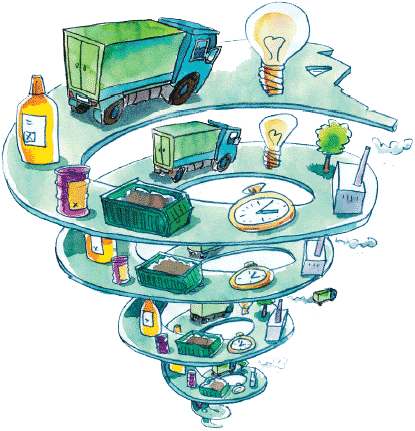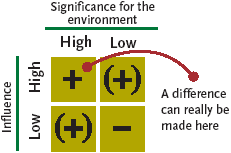An introduction to Life-Cycle Thinking and Management
3. How to begin?

Product-oriented environmental initiatives up until now have focused on the method - a detailed life-cycle assessment, followed by determination of the most significant environmental impacts created during a product's life cycle. These efforts have often ended up dealing with data collection and data issues, rather than concrete strategies concerning how an enterprise can improve the environmental profile of a product.
If an enterprise has not previously investigated a product's environmental impact, then it is a good idea to take a stepby step approach and begin by focusing on a life-cycle perspective and on concrete possibilities to improve the environmental characteristics of a product.
A step by step appraoch
A step-by-step approach may involve the following phases, which are also the same phases an enterprise goes through when introducing an environmental management system (see Figure 5).
1. Policy - setting goals and determining the ambition level
A life-cycle-based environmental policy ought to be visionary and longrange while also being realistic and concrete. An enterprise must therefore, set both long-range objectives and a concrete ambition level. This will avoid confusing signals, both internally and with collaboration partners.There must be no "hotchpotch" between policy and practice: between what an enterprise "says" and what it "does".
Setting goals and determining the level of ambition ensures conformity between policy and actions.There are at least three different ambition levels which can be distinguished.
| Internal readiness and commitment to environmental improvements | |
| Environmental profile for cleaner products | |
| Marketing of cleaner products |
1. |
Policy |
- |
Set objectives and determine the ambition level |
2. |
Organise |
- |
Get management and employees organised |
3. |
Survey |
- |
Get an overview over the existing knowledge |
4. |
Goal |
- |
Select an area where the efforts will be directed, determine the goal(s), and make an action plan |
5. |
Environmental improvements |
- |
Put the plan into action |
6. |
Reporting |
- |
Document the effect(s) of the efforts and make the results public |
7. |
Begin again |
- |
Evaluate the experience, revise the policy, organisation, etc. |
8. |
Undertake supplementary investigations and obtain further information |
||
9. |
Specify existing initiative areas and select new areas and goals |
||
10. |
Etc. Etc. Etc. |
||
Figure 5.
Environmental improvements are the turning point
Distinguishing between these ambition levels allows a step-by-step plan for environmental improvements which gradually becomes more ambitious as new knowledge and experience associated with setting plans into action are obtained (see also tools - Chapter 10).
When the environmental policy has been set the enterprise must organise the effort and collect information.
2. Organisation
An organisation of the initiative is, of course, "alpha and omega" to the success of a project, so this step is discussed in greater detail later (see Chapter 4).
3. Survey - get an overview over the existing knowledge
The majority of enterprises have a great deal of knowledge regarding the environmental impacts of their products and processes collected and available, for example, in their environmental approval or green accounts. In general, this information is presented in terms of the production process, rather than in terms of the products.The first challenge is thus to obtain information relating to particular products. This latter information also provides the enterprise with crucial figures for production costs related to product groups or series.
The next challenge is to obtain an overview of the knowledge and experience found in the literature and held by collaboration partners. This type of knowledge survey may be simplified by using the "sparring partners" within the enterprise's network (see also Chapter 9). Extending the information survey to suppliers, business associations, authorities, retail shops, scientific institutions, etc. ensures that information is obtained from at least three areas (see also Table 1, above):
Table 1.
The survey:
A. Environmental impacts
B. Market/commercial conditions
C. Partners
|
Based on the ambition level, the enterprise must limit the information collected to what
is necessary and practical. Enterprises which consider too many aspects or potential
situations during the data-collection phase risk getting so bogged down in information
that the project "dies".
Product-orientated green accounts, six or seven telephone conversations with partners, and some reading are sufficient to obtain the first overview.This overview provides background information which may be drawn upon later if detailed, goal-orientated information collection and investigation are undertaken in conjunction with a raised level of ambition, or new demands.

Figure 6
Prioritising the effort
4. Select an area where the efforts will be directed, determine goal(s) and make an action plan
Constructive responses to the questions listed above provide a sound basis for selecting an area where environmental improvement would be worth pursuing. In some cases the environmental problems identified by an enterprise may be solved by another's efforts, for example, a new technology is nearly functional or a supplier is phasing out harmful substances.
Based on the current situation and knowledge, an enterprise must decide which area will be prioritised with regard to environmental initiatives. This decision may be made based on the following three questions:
| Where are the most significant environmental problems in the product's life cycle? (relevance) | |
| Where is it possible to achieve environmental improvements? (potential) | |
| Where can the enterprise make a difference? (influence) |
The Danish company Brdr. Hartmann has weighed such questions during the planning of their life-cycle-based environmental initiative. By considering "relevance" and "potential" together in the context of environmental initiatives, they developed the following simple prioritising model, Figure 6.
Remember that an enterprise may have several "shots" at environmental problems. Choose several initiative areas so that an enterprise's various departments, for example, procurement, logistics, etc. also have the opportunity to contribute to minimising the products' environmental impact.
Concrete goals and an action plan must be defined for each initiative area:Who is responsible for doing what and when. An action plan is a good means of explicitly stating the goals, delegating responsibility and setting the time frames, so that the circumstances surrounding the environmental initiative are clear for both management and employees.
5. Make environmental improvements - put the plan into action
Good planning is important, but it is the practical results which create credibility, enthusiasm, and active support for an environmental initiative.
Focusing on the entire life cycle of a product will identify numerous possibilities for obvious environmental improvements - "easy rewards" which will improve a product's profile. Putting focus on a concrete problem will generate ideas for improvements.
Environmental initiatives must also involve new challenges.What if an enterprise were required to take back all its scrap products according to an EU directive that enters into force in one year? Such a demand would, of course, be added to an enterprise's list of initiative area and an action plan would provide explicit details regarding the concrete initiative. The goal of recycling materials and product parts would require a rethinking of the product. Some of the considerations are listed below:
| fewer materials in a product make it easier to recycle | |
| a product which is easily taken apart is also more easily recycled | |
| the materials selected for the product are recyclable | |
| the product is built in modules which facilitate repairs of selected parts | |
| redesign the product so that parts of the original may be re-used in new products |
6. Reporting - document the effects of the efforts and make the results public
With regard to the commitment of management and employees, it is crucial that the effect(s) of the efforts are documented and that the results are made public. Such documentation gives credibility when answering inquiries from customers, suppliers, etc. regarding the enterprise's environmental policy.
The form of documentation is completely dependent upon the ambition level in the enterprise. It is advantageous for enterprises to have some insight into the environmental impacts the enterprise's target group prioritises, so that communication can be aimed at this group.
Green accounts, which already contain details of an enterprise's environmental initiatives, may be redirected to be more product-orientated, thus providing a good forum to document results and make them visible to the public. Productorientated green accounts may address:
| To what degree has the energy consumption of the product in the user-phase been reduced? | |
| How much of the product can be recycled? | |
| To what degree and how has transport been optimised? |
Results may also be made visible by calculating some key figures, for example energy consumption during production of the product, which can be made public via an environmental folder, ecolabelling, or an environmental product declaration. This is discussed in greater detail in Chapter 8.
7. Keep the process going - evaluate experience and revise policies and organisational structures
After completing the first round of improvements to the environmental profile of an enterprise and a product, it is a good idea to "take a deep breath" and evaluate the experience:
| What went well and not so well? | |
| How can the effort be improved? | |
| Should more of the employees be involved in the environmental initiative? | |
| Should the efforts be focused in a different direction? | |
| Were the appropriate means and methods used? | |
| Should more partners be involved? | |
| Should the level of ambition be raised? | |
| Etc. |
Such an evaluation, conducted once a year, makes an excellent background for adjusting an enterprise's environmental policy so that it is consistent with the actual efforts. After such an evaluation an enterprise may decide to continue at the same ambition level until the internal environmental commitment and readiness to undertake initiatives are well established, or until partners or others voice demands regarding more extensive environmental commitment, and thus a higher ambition level.
Remember - the idea behind a stepbystep approach is ensuring a reciprocal interaction between developing knowledge concerning a product's environmental impact, market demands, etc. and implementation of concrete productoriented environmental improvements.
8. Undertake supplementary investigations and obtain further knowledge
Through the experience from the first round of environmental improvements, an enterprise has likely identified areas where further investigation may be advantageous.
If demands are made requiring an enterprise to supply further documentation regarding the environmental impact of a product, then a simple environmental assessment is appropriate. If it becomes evident that there are significant environmental impacts in the user-phase, then investigation of consumer desires and demands would be an obvious method to obtain ideas for design changes or to develop better instructions for product use. If an enterprise uses chemicals or materials which are on the list of undesirable substances it would be sensible to begin phasing them out.
It is much easier to develop a knowledgebase if there is good cooperation and trust among producers, suppliers, retail store owners, disposal facilities and other stakeholders in the product chain. (See chapter 9, Cooperation in the product chain).
9. Define the environmental initiative area and the goal(s)
On the basis of experience, the initiative area and goal(s) are redefined and a new round of efforts begins with plans, improvements, etc. Focus remains on achieving concrete environmental improvements to the product profile, while realising results during the improvement process.